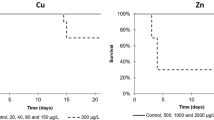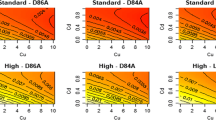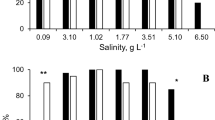Abstract
In nature the effect that pollutants exert on exposed organisms could depend on the state and dynamics of natural environmental factors as well as on the internal state of the exposed organisms. In this study we evaluated how level and variability of food, as well as the age of exposure can modify the effects of the pesticide deltamethrin on the freshwater crustacean Daphnia magna. The effects of the pesticide were measured on life history and nutritional traits (lipid storage) of the test organisms, which were exposed at different juvenile ages under constant (high and low) food as well as food shortage treatments. Our results show that deltamethrin exerts significant effects on all evaluated traits of Daphnia, and several responses are shaped by deltamethrin interacting with food and age of exposure. Two novel results are remarkable. First, at constant food treatments the effects of the pesticide were stronger on younger individuals, whereas in food shortage treatments the effects were stronger on older individuals. Second, we observed that deltamethrin exerted stronger effects on certain traits (survival, body growth and median consumption time of lipids) in Daphnia exposed to food shortage, as compared to constant low food treatments. Our results highlight the importance of the dynamics of resources in freshwater systems for shaping the vulnerability of herbivores to pollutants released to the ecosystem and improve our understanding of how the organismal responses to environmental stress are determined by the ecological condition of the organisms at the instant of being exposed to perturbations.



Similar content being viewed by others
References
Aladin NV, Potts WTW (1995) Osmoregulatory capacity of the cladocera. J Comp Physiol B164:671–683
Antunes SC, Castro BB, Goncalves F (2003) Effect of food level on the acute and chronic responses of daphnids to lindane. Environ Pollut 127:367–375
ASTM (1980) Standard practice for conducting acute toxicity tests with fishes, macroinvertebrates and amphibians. American Standards for Testing and Materials, Philadelphia
Beketov MA (2004) Comparative Sensitivity to the insecticides Deltamethrin and Esfenvalerate of some aquatic insect larvae (Ephemeroptera and Odonata) and Daphnia magna. Russ J Ecol 35:200–204
Bielmeyer GK, Brix KV, Capo TR, Grosell M (2005) The effects of metals on embryo-larval and adult life stages of the sea urchin, Diadema antillarum. Aquat Toxicol 74:254–263
BioPix (2008) BioPixsoftware, ver. iQ 2.0, computer program, BioPix Software, Gothenburg, Sweden
Bychek EA, Dobson GA, Harwood JL, Guschina IA (2005) Daphnia magna can tolerate short-term starvation without major changes in lipid metabolism. Lipids 40:599–608
Chevrier J, Dewailly E, Ayotte P, Mauriege P, Despres JP, Tremblay A (2000) Body weight loss increases plasma and adipose tissue concentrations of potentially toxic pollutants in obese individuals. Int J Obes 24:1272–1278
Christensen BT, Lauridsen TL, Ravn HW (2005) A comparison of feeding efficiency and swimming ability of Daphnia magna exposed to cypermethrin. Aquat Toxicol 73:210–220
Cloern JE, Jassby AD (2008) Complex seasonal patterns of primary producers at the land-sea interface. Ecol Lett 11:1294–1303
Coors A, De Meester L (2008) Synergistic antagonistic and additive effects of multiple stressors: predation threat parasitism and pesticide exposure in Daphnia magna. J Appl Ecol 45:1820–1828
Day K, Kaushik NK (1987) Short-term exposure of zooplankton to the synthetic pyrethroid fenvalerate, and its effects on rates of filtration and assimilation of the alga, Chlamydomonas reinhardtii. Arch Environ Cont Tox 16:423–432
De Coen WM, Janssen CR, Segner H (2001) The use of biomarkers in Daphnia magna toxicity testing V. In vivo alterations in the carbohydrate metabolism of Daphnia magna exposed to sublethal concentrations of mercury and lindane. Ecotox Environ Safe 48:223–234
Duquesne S, Reynaldi S, Liess M (2006) Effects of the organophosphate paraoxon-methyl on survival and reproduction of Daphnia magna: importance of exposure duration and recovery. Environ Toxicol Chem 25:1196–1199
Enserink L, Luttmer W, Maas-Diepeveen H (1990) Reproductive strategy of Daphnia magna affects the sensitivity of its progeny in acute toxicity tests. Aquat Toxicol 17:15–26
Folch J, Lees M, Stanley GHS (1957) A simple method for the isolation and purification of total lipids from animal tissues. J Biol Chem 226:497–509
Folt CL, Chen CY, Moore MV, Burnaford J (1999) Synergism and antagonism among multiple stressors. Limnol Oceanogr 44:864–877
Forbes VE, Cold A (2005) Effects of the pyrethroids fenvalerate on life-cycle traits and population dynamics of Chironomus riparius-Importance of exposure scenario. Environ Toxicol Chem 24:78–86
Forget J, Pavillon JF, Menasria MR, Bocquené G (1998) Mortality and LC50 values for several stages of the marine copepod Tigriopus brevicornis (Muller) exposed to the metals arsenic and cadmium and the pesticides atrazine, carbofuran, dichlorvos and malathion. Ecotox Environ Safe 40:239–244
Fulford RS, Rice JA, Miller TJ, Binkowski FP, Dettmers JM, Belonger B (2006) Foraging selectivity by larval yellow perch (Perca flavescens): implications for understanding recruitment in small and large lakes. Can J Fish Aquat Sci 63:28–42
Goulden CE, Hornig LL (1980) Population oscillations and energy reserves in planktonic c1adocera and their consequences to competition. P Natl Acad Sci USA 77:1716–1720
Guilhermino L, Sobral O, Chastinet C, Ribeiro R, Goncalves F, Silva MC, Soares AMVM (1999) A Daphnia magna first-brood chronic test: an alternative to the conventional 21-day chronic bioassay? Ecotox Environ Safe 42:67–74
Haupt F, Stockenreiter M, Baumgartner M, Boersma M, Stibor H (2009) Daphnia diel vertical migration: implications beyond zooplankton. J Plankton Res 31:515–524
Heugens EH, Hendriks AJ, Dekker T, Van Straalen NM, Admiraal W (2001) A review of the effects of multiple stressors on aquatic organisms and analysis of uncertainty factors for use in risk assessment. Cr Rev Toxicol 31:247–284
Hoang TC, Klaine SJ (2007) Influence of organism age on metal toxicity to Daphnia magna. Environ Toxicol Chem 26:1198–1204
Holmstrup M, Bindesbol AM, Oostingh GJ, Duschl A, Scheil V, Kohler HR, Loureiro S, Soares AM, Ferreira AL, Kienle C, Gerhardt A, Laskowski R, Kramarz PE, Bayley M, Svendsen C, Spurgeon DJ (2010) Interactions between effects of environmental chemicals and natural stressors: a review. Sci Total Environ 408:3746–3762
Hue O, Marcotte J, Berrigan F, Simoneau M, Dore J, Marceau P et al (2006) Increased plasma levels of toxic pollutants accompanying weight loss induced by hypocaloric diet or by bariatric surgery. Obes Surg 16:1145–1154
Imbeault P, Chevrier J, Dewaill E, Ayotte P, Despres JP, Tremblay A et al (2001) Increase in plasma pollutant levels in response to weight loss in humans is related to in vitro subcutaneous adipocyte basal lipolysis. Int J Obes 25:1585–1591
Imbeault P, Tremblay A, Simoneau JA, Joanisse DR (2002) Weight loss-induced rise in plasma pollutant is associated with reduced skeletal muscle oxidative capacity. Am J Physiol-Endoc M 282:E574–E579
Jonker D, Freidig AP, Groten JP, de Hollander AEM, Stierum RH, Woutersen RA, Feron VJ (2004) Safety evaluation of chemical mixtures and combinations of chemical and non-chemical stressors. Rev Environ Health 19:83–139
Kast-Hutcheson K, Rider CV, LeBlanc GA (2001) The fungicide propiconazole interferes with embryonic development of the crustacean Daphnia magna. Environ Toxicol Chem 20:502–509
Klein B (2000) Age as a factor influencing results in the acute daphnid test with Daphnia magna Straus. Water Res 34:1419–1424
Kreuger J (1998) Pesticides in stream water within an agricultural catchment in southern Sweden, 1990-1996. Sci Total Environ 216:227–251
Lampert W (1987) Feeding and nutrition in Daphnia. In: Peters RH, Bernardi R de (eds) Daphnia. Mem Ist Ital Idrobiol 45:143–192
LeBlanc GA, Surprenant DC (1983) The acute and chronic toxicity of acetone, dimethylformamide, and triethylene glycol to Daphnia magna (Straus). Arch Environ Con Tox 12:305–310
Liess M, Schulz R, Liess MHD, Rother B, Kreuzig R (1999) Determination of insecticide contamination in agricultural headwater streams. Water Res 33:239–247
Lim S, Son HK, Park SK, Jacobs DR, Lee DH (2011) Inverse associations between long-term weight change and serum concentrations of persistent organic pollutants. Int J Obes 35:744–747
Maguire RJ, Carey JH, Hart JH, Tkacz RJ, Lee H-B (1989) Persistence and fate of deltamethrin sprayed on a pond. J Agric Food Chem 37:1153–1159
Manly BFJ (1997) A program for randomization testing. Centre for Applications of Statistics and Mathematics University of Otago, Dunedin
Manyin T, Rowe C (2010) Reproductive and life stage-specific effects of aqueous copper on the grass shrimp, Palaemonetes pugio. Mar Environ Res 69:152–157
McCauley E, Murdoch WW, Nisbet RM, Gurney WSC (1990) The physiological ecology of Daphnia: development of a model of growth and reproduction. Ecology 71:703–715
Medina M, Barata C, Telfer T, Baird D (2002) Age-and sex related variation in sensitivity to the pyrethroid cypermethrin in the marine copepod Acartia tonsa Dana. Arch Environ Con Tox 42:17–22
OECD (2004) OECD guidelines for testing of chemicals. Guideline 202: Daphnia sp., Acute immobilisation test, adopted April 2004
Petersen GI, Kristensen P (1998) Bioaccumulation of lipophilic substances in fish early life stages. Environ Toxicol Chem 17:1385–1395
Pieters BJ, Jager T, Kraak MHS, Admiraal W (2006) Modeling responses of Daphnia magna to pesticide pulse exposure under varying food conditions: intrinsic versus apparent sensitivity. Ecotoxicology 15:601–608
Pijanowska J, Dawidowicz P, Howe A, Weider LJ (2006) Predator-induced shifts in Daphnia life-histories under different food regimes. Arch Hydrobiol 167:37–54
Ramos-Jiliberto R, Dauelsberg P, Zuñiga LR (2004) Differential tolerance to ultraviolet-B light and photo enzymatic repair in cladocerans from a Chilean lake. Mar Freshwater Res 55:193–200
Reichwaldt ES, Wolf ID, Stibor H (2004) Effects of a fluctuating temperature regime experienced by Daphnia during diel vertical migration on Daphnia life history parameters. Hydrobiologia 543:199–205
Reynaldi S, Duquesne S, Jung K, Liess M (2006) Linking feeding activity and maturation of Daphnia magna following short-term exposure to fenvalerate. Environ Toxicol Chem 25:1826–1830
Ringwood AH (1990) The Relative Sensitivities of Different Life Stages of Isognomon californicum to Cadmium Toxicity. Arch Environ Contam Toxicol 19:338–340
Schulz R, Liess M (2001) Toxicity of aqueous-phase and suspended particle-associated fenvalerate: chronic effects after pulse-dosed exposure of Limnephilus lunatus (Trichoptera). Environ Toxicol Chem 20:185–190
Smolders R, Baillieul M, Blust R (2005) Relationship between the energy status of Daphnia magna and its sensitivity to environmental stress. Aquat Toxicol 73:155–170
Sommer U, Adrian R, De Senerpont Domis L, Elser JJ, Gaedke U, Ibelings B et al (2012) Beyong the plankton ecology group (PEG) model: mechanisms driving plankton succession. Ann Rev Ecol Evol S 43:429–448
Tessier AJ, Goulden CE (1982) Estimating food limitation in cladoceran populations. Limnol Oceanogr 27(4):707–717
Tessier AJ, Henry LL, Goulden CE, Durand MW (1983) Starvation in Daphnia: energy reserves and reproductive allocation. Limnol Oceanogr 28:667–676
Toumi H, Bournaiza M, Immel F, Sohm B, Felten V, Ferard JF (2014) Effect of deltamethrin (pyrethroid insecticide) on two clones of Daphnia magna (Crustacea, Cladocera): a proteomic investigation. Aquat Toxicol 148:40–47
Viran R, ÜnlüErkoç F, Polat H, Koçak O (2003) Investigation of acute toxicity of deltamethrin on guppies (Poecilia reticulata). Ecotox Environ Safe 55:82–85
Voeltz NJ, Zuelling RE, Shieh SH, Ward V (2005) The effects of urban areas on benthic macroinvertebrates in two Colorado plains rivers. Environ Monit Assess 101:175–202
Xiu R, Xu Y, Gao S (1989) Toxicity of the new pyrethroid insecticide, deltamethrin, to Daphnia magna. Hydrobiologia 188–189:411–413
Acknowledgments
This study was supported by FONDECYT grant 1120958 to R. R. -J. C. A. R and J. G-B acknowledge graduate scholarships from CONICYT. We thank M. Fernandez-González for his help in performing lab experiments and M. Arancibia for technical lab assistance.
Author information
Authors and Affiliations
Corresponding author
Electronic supplementary material
Below is the link to the electronic supplementary material.
About this article
Cite this article
Reyes, C.A., Ramos-Jiliberto, R. & González-Barrientos, J. Temporal variability of food determines the outcome of pesticide exposure in Daphnia . Ecol Res 30, 451–460 (2015). https://doi.org/10.1007/s11284-014-1240-4
Received:
Accepted:
Published:
Issue Date:
DOI: https://doi.org/10.1007/s11284-014-1240-4




